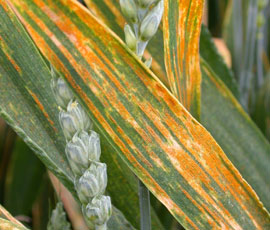Yellow Rust in Wheat
Yellow rust is a fungal disease which turns the crops leaves into yellowish colour, stops photosynthesis and causes tremendous losses in yield
The disease appears as yellow coloured, powdery linear stripes on the leaves. When touched, the yellow coloured spore mass sticks to the fingers, a conspicuous criteria for disease identification
Symptoms
The first sign of stripe rust is the appearance of yellow streaks (pre-pustules), followed by small, bright yellow, elongated uredial pustules arranged in conspicuous rows on the leaves, leaf sheaths, glumes and). Mature pustules will break open and release yellow-orange masses of urediniospores. In some varieties, long, narrow yellow stripes will develop on leaves. The infected tissues may become brown and dry as the plant matures or becomes stressed Severe early infection can result in plant stunting.
Control
Use of resistant varieties is the best way to control wheat losses to stripe rust. Two types of genetic resistance to stripe rust are known: a) seedling resistance and b) adult plant resistance. Seedling resistance, which is controlled by a single gene.
Yellow rust is easier to control than brown rust with poorly leaf systemic or very fast moving fungicides. This is because it forms its ‘looser’ elongated pustules closer to the leaf surface, whereas brown rust forms very waxy dense pustules in the middle of the leaf – making it trickier for fungicides to access. Yellow rust is eight times less efficient at penetrating the wheat leaf than brown rust, because it doesn’t build specialised infection structures (appressoria). This renders it an easier target for fungicides with long-lasting protectant activity.
It is recommended that you focus your foliar disease control programme on Septoria tritici and build in additive contingency plans for less predictable yellow rust.




Comments are closed.